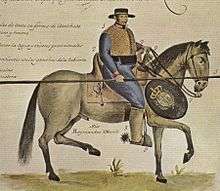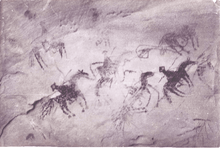Soldado de cuera

1: Leather jacket with seven layers
2: Saddle pommel and cantle
3: Carbine
4: Saddle bag
5: Lance
6: Pistols hanging on each side of the fender
7: Buckler
8: Boots and spurs
9: Wooden stirrups
10: Cartridge box [1]

The soldado de cuera (English, "leather-jacket soldier")[2] served in the frontier garrisons of northern New Spain.[3] They were mounted and were an exclusive corps in the Spanish Empire. They took their name from the multi-layered deer-skin cloak they wore as protection against Indian arrows. When New Spain's visitador (inspector general) José de Gálvez organized the Portola Expedition, he was accompanied by a party of 25 soldiers, the "finest horsemen in the world, and among these soldiers who best earn their bread from the august monarch whom they serve."[2]
The cuera, which gave them their name, was a leather jacket, like a coat without sleeves, proof against the Indians' arrows except at very close range. For additional armor they had shields and chaps. The shields, carried on the left arm, were made of two plies of bull's hide, and would turn either arrow or spear. The leather chaps or aprons, fastened to the pommel of the saddle, protected legs and thighs from brush and cactus spines.[2]
They were armed with a short musket, a pair of pistols, a bow and arrows, a short sword, a lance, and a bull-hide shield (adarga). These frontier soldiers were recruited from among the mestizo population, Hispanicized Indians, and freed slaves. Most of the officers were Criollos, whereas very few of the enlisted men had this distinction. The soldados de cuera manned the presidios that stretched from Los Adaes, Louisiana, in the East, across Texas, New Mexico, and Arizona, to the Pacific Coast of Alta California in the West.[4]
References
Notes
- ↑ Bueno, José María (2014), Las Guarniciones de los Presidios de Nueva España: Los Dragones Cuera, Madrid: Ministerio de Defensa. p. 21.
- 1 2 3 Crespí, Juan, 1721-1782. Fray Juan Crespi: Missionary Explorer On the Pacific Coast, 1769-1774. Berkeley, Calif.: University of California press, 1927.
- ↑ "Antigua California: Mission and Colony on the Peninsular Frontier, 1697-1768 - Harry Crosby - Google Books". Books.google.com. Retrieved 2012-09-15.
- ↑ Conor McMahon, "The Espada Ancha in New Mexico" Retrieved 2016-03-31.